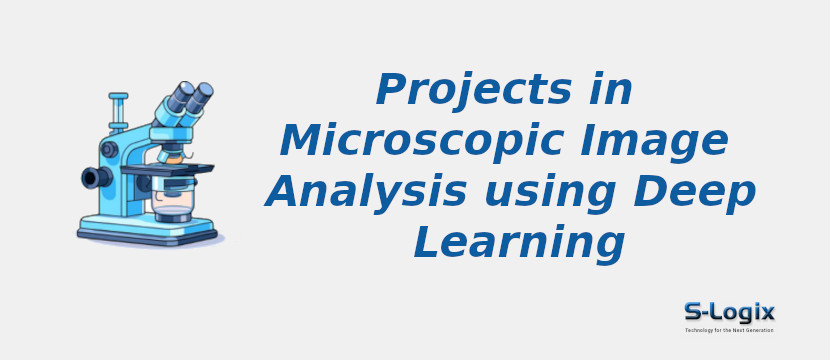Project Background:
The Microscopic Image Analysis using Deep Learning involves leveraging advanced neural network architectures to extract meaningful information and insights from microscopic images. Microscopic imaging is pivotal in various scientific and medical domains, offering a detailed view of cellular and subcellular structures. Traditional image analysis methods often face challenges in handling the complexity and variability inherent in microscopic images. Deep learning, particularly convolutional neural networks (CNNs) and other specialized architectures emerges as a powerful solution to learn hierarchical features and patterns from these images automatically. The project aims to develop and optimize deep learning models capable of cell segmentation, classification, and feature extraction tasks. The project background encompasses the intersection of deep learning, computer vision, and life sciences, with the potential to revolutionize how microscopic images are interpreted and analyzed for scientific and medical purposes.
Problem Statement
- Microscopic Image Analysis addresses the inherent complexities and challenges of extracting meaningful information from microscopic images.
-
Traditional image analysis methods often struggle with the intricacies of diverse cell morphologies, variations in staining techniques, and the nuanced details in microscopic structures.
-
Among the key challenges are ensuring robust performance across different types of microscopy, handling variations in image quality, and dealing with limited labeled data for training deep models.
-
Additionally, interpretability models in the context of microscopic image analysis are crucial, as the decisions made by these models can have profound implications in scientific and medical applications.
Aim and Objectives
- Develop advanced deep learning models for the automated analysis of microscopic images, enhancing accuracy and efficiency in tasks such as cell segmentation, classification, and feature extraction.
-
Design and optimize deep learning architectures for robust microscopic image analysis.
-
Address the challenges of diverse cell morphologies and variations in staining techniques.
-
Ensure model adaptability across different types of microscopy.
-
Handle limited labeled data through techniques like transfer learning and data augmentation.
-
Enhance the interpretability of deep learning models for transparent decision-making.
-
Facilitate accurate and efficient cell segmentation and classification.
-
Explore feature extraction methods for extracting meaningful information from microscopic structures.
-
Validate and benchmark the developed models on diverse microscopic datasets.
-
Provide a user-friendly interface for researchers and healthcare professionals.
Contributions to Microscopic Image Analysis using Deep Learning
1. Developing specialized deep learning architectures tailored for microscopic image analysis optimizes model structures for cell segmentation, classification, and feature extraction tasks.
2.
Innovations in transfer learning techniques enable the effective utilization of pre-trained models on large datasets to handle limited labeled data in microscopic image analysis.
3.
Achievements in improving the accuracy and efficiency of cell segmentation and classification tasks reduce the need for manual intervention in these critical analysis steps.
4.
Developing advanced feature extraction methods to capture meaningful information from microscopic structures contributes to a deeper understanding of cellular morphology and behavior.
5.
Efforts to integrate deep learning models into healthcare systems paving the way for automated and accurate analysis of microscopic images in clinical settings.
6.
Development of explanatory visualization techniques that illustrate the decision-making process of deep learning models, enhancing transparency and aiding researchers in understanding model predictions.
Deep Learning Algorithms for Microscopic Image Analysis Using Deep Learning
- Convolutional Neural Networks (CNNs)
-
U-Net Architecture
-
Residual Networks (ResNets)
-
Inception Networks
-
DenseNet
-
Spatial Transformer Networks (STN)
-
Capsule Networks (CapsNets)
-
Recurrent Neural Networks (RNNs) for sequential data analysis
-
Long Short-Term Memory Networks (LSTMs)
-
Autoencoders for unsupervised feature learning
-
Generative Adversarial Networks
-
Siamese Networks for similarity-based tasks
-
Spatial Pyramid Pooling Networks (SPPN)
-
Neural Architecture Search (NAS) models
Datasets for Microscopic Image Analysis Using Deep Learning
- CAMELYON16: Cancer Metastases in Lymph Nodes
-
Kaggle - Data Science Bowl 2018: Nuclei Segmentation
-
BBBC039: HeLa Cells
-
BBBC021: Yeast Cells
-
Fungi-3D: 3D Segmentation of Fungal Cells
-
The Cell Atlas: Human Protein Atlas
-
MoNuSeg: Multi-organ Nuclei Segmentation
-
VOC2012: Visual Object Classes Challenge
-
TCGA: The Cancer Genome Atlas
-
DRIVE: Digital Retinal Images for Vessel Extraction
-
Pap Smear Images for Cervical Cancer Screening
-
AIDPATH: Pathology Whole Slide Images
-
NIH Chest X-ray Dataset for Tuberculosis Detection
-
MITOS-ATYPIA-14: Mitosis Detection in Breast Cancer Histology
-
Herlev Breast Cancer Dataset
-
PhC-U373: Holographic Phase Contrast Images of Cells
Performance Metrics
- Intersection over Union (IoU)
-
Dice Coefficient
-
Precision
-
Recall
-
F1 Score
-
Accuracy
-
Receiver Operating Characteristic (ROC) Curve
-
Area Under the ROC Curve (AUC-ROC)
-
Precision-Recall Curve
-
Area Under the Precision-Recall Curve (AUC-PR)
-
Mean Squared Error (MSE)
-
Mean Absolute Error (MAE)
-
Average Symmetric Surface Distance (ASSD)
-
Normalized Mutual Information (NMI)
-
Cohens Kappa Coefficient
-
Matthews Correlation Coefficient (MCC)
Software Tools and Technologies
Operating System: Ubuntu 18.04 LTS 64bit / Windows 10
Development Tools: Anaconda3, Spyder 5.0, Jupyter Notebook
Language Version: Python 3.9
Python Libraries:
1. Python ML Libraries:
- Scikit-Learn
- Numpy
- Pandas
- Matplotlib
- Seaborn
- Docker
- MLflow
2. Deep Learning Frameworks:
- Keras
- TensorFlow
- PyTorch
